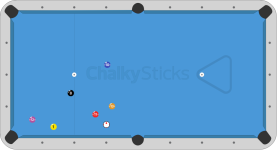had two shots come up in today's session that I sometimes hit well, but today hit poorly
and I realized I'm just kind of winging it on them..for the draw I usually hit the same place on the cb, but not as firm
I've experimented with hitting the draw higher up and more firm, but I don't gravitate towards that way..should I?
any advice appreciated..enclosing an 8-ball diagram of the draw shot that I ended up getting hooked on
I also missed position on a similar shot with follow, too long for force follow- I think I just hit too high
and I realized I'm just kind of winging it on them..for the draw I usually hit the same place on the cb, but not as firm
I've experimented with hitting the draw higher up and more firm, but I don't gravitate towards that way..should I?
any advice appreciated..enclosing an 8-ball diagram of the draw shot that I ended up getting hooked on
I also missed position on a similar shot with follow, too long for force follow- I think I just hit too high
